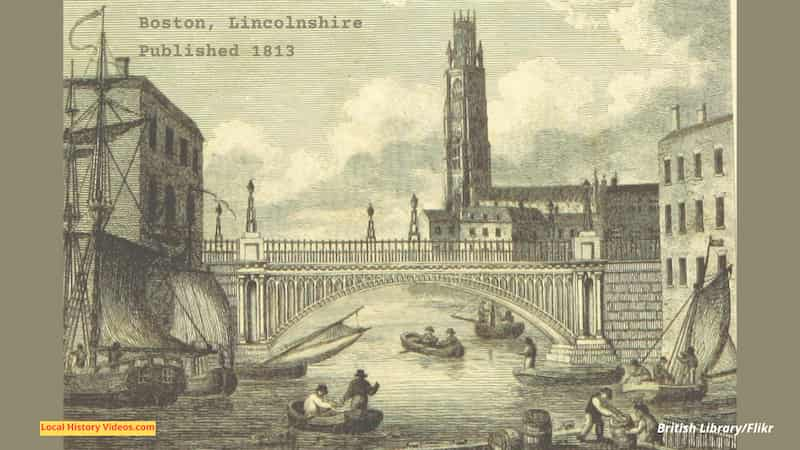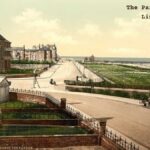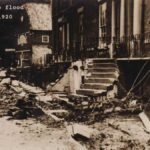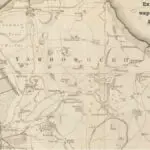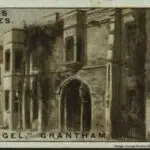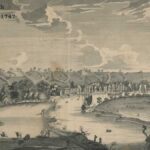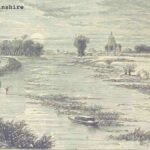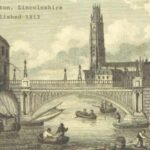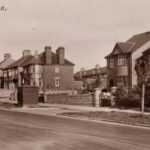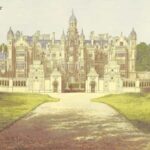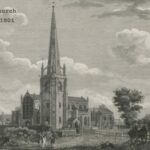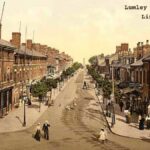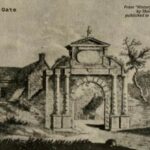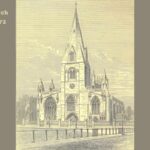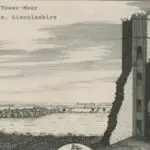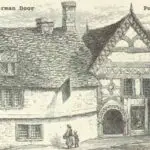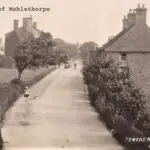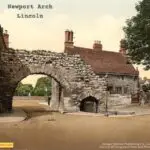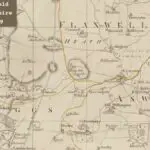Glimpse history through old images of Boston, Lincolnshire, England.
Repatriated Prisoners
This short reel shows Prisoners of War being repatriated to England after their release from capture in the Great War, later known as World War 1. Some of the men are wounded.
The reel is marked Boston, although the only scenes we see are on deck apart from a moment as they dock and shake hands with the Mayor.
Home From Durance Vile (1914-1918) – British Pathé (YouTube)
Boston Fair 1928
In 1928, the Mayor officially opened the Boston Fair, which was one of the few Charter Fairs, established by Royal Charter, still in existence.
There’s a brief glimpse of a banner which says “….to keep the STUMP UP..£30,00(0) URGENTLY N(EEDED)”.
It’s referring to the the tower at St Botolph’s Church, known as the Boston Stump. £30,000 was an astonishing amount of money in 1928, when a nice house cost a few hundred pounds.
As the Mayor talks, we see his wife beaming at the camera.
After a quick shot of the crowds, the Mayor is joined on the Merry-go-round horses by several other middle aged men.
It ends with a visual sweep across the site, where the event is very well attended.
Boston fair is opened by proclamation of the Mayor (1928) – British Pathé (YouTube)
At the time of posting, this short film had been watched just 25 times – despite being publicly available for more than a year. I regularly come across these little gems that deserve more views, which was my motivation to create LocalHistoryVideos.com.
Boston Sleepers 1933
In just over a minute and a half, see how wooden sleepers for the East Coast railway lines used to be produced on the outskirts of Boston.
Notice the home made stairways to get to the top of the pile, and the onsite railway line.
It’s interesting to see how mecahnised the factory was, even though this was 1933.
You’ll notice the men work with sleepers swinging about in the air and open hot creosote tanks with absolutely no safety equipment at all.
Sleepers (1933) – British Pathé (YouTube)
Captain Tressider’s Pets (1948)
Captain Tressider was the publican running Boston’s Cross Keys Hotel.
He had two pets. One was Billy the dog; the other was Sally the Seal.
In addition to the interior of the Cross Keys Hotel bar, we get a second’s glimpse at a row of houses.
These Animals Get Around (1948)- British Pathé (YouTube)
A bit of Boston history
Extract from: “Lincolnshire in 1836: displayed in a series of engravings, with accompanying descriptions [by M. Saunders]“, by Mary Saunders
Published in 1836
Pages 44 – 49
The town and port of Boston stand upon the river Witham,
about five miles from its mouth, being 32 miles s. E. of Lincoln,
and 116 N. from London. Its site, as well as the country for
many miles round, is what is sometimes expressively called” a
dead flat.” The parish is about two miles fong, and one mile
broad; the town takes up about half this extent.
Boston was at
one time a place of immense trade and wealth, as the fact of Boston
paying the largest amount ( with the exception of London ) towards
a general tax levied on the ports of England, satisfactorily proves.
The town, on the east side of the river, principally consists of one
long and slightly curving line, running from the Spilsby road at
one end, towards the road to the sea coast at the other, bearing in
its course the respective names, Wide Bargate, Bargate, Market
Place, and South Street, crossed at right angles in the market
place, by various lanes, & c. leading into other short streets; and
on the western side of the river, by a long street called High – Street,
running from the bridge to the London road; and from this street,
another long one runs at right angles, called West – Street, towards
the road to Sleaford. The general appearance of the town is very
good; it is well lighted and paved, the houses generally, even of
the lower classes, appear to wear an air of comfort; the streets are
generally broad, and the Market – Place particularly, is a very noble
spacious area, around which are the principal shops.
The first historical notice that we possess relative to Boston, is
in the Saxon Chronicle, where it is stated that St. Botolph built
a monastery here, A. D. 654, upon a desert piece of ground given
him for that purpose by Ethelmund, king of the South Angles.”
This monastery, and the town ( if any then existed ) were destroyed
by the Danes in 870. From that time nothing further is known
till William the Conqueror’s reign, when the land in the neigh
bourhood having been granted in shares to three or four earls, his
followers, and who fixed their residences in the vicinity, Boston
rose rapidly into importance. In 1241, King Henry 4th gave by
special charter to the Earl of Richmond, the town of Boston with
the soke and the faire. Some idea of the importance of the town
may be gathered from the fact, that about this period, or soon after,
merchants from Ypres, Cologne, Caen, Ostend, Arras, & c. had
establishments in the town; and also from the perusal of the following document, extracted from the great roll of the time of the
17th Edward 1st.
The amount of duties collected at the other ports was trifling in
comparison with these three, and consequently the traffic of Boston, surpassing as it did even that of the metropolis, and constituting more than one – third of the customs collected throughout the
kingdom, must have been immense. The annual mart held here
was the emporium of business for the great part of the eastern side
of the kingdom; and as it must be observed that in those times
there were few or no shops, & c., consequently the public generally
resorted to those marts, to purchase nearly all the necessaries as
well as the luxuries of life, such as cloth, groceries, & c. & c. Boston mart appears to have been of the most famous of these.
Two
great misfortunes befel the town in 1280 and 1286: in the former
year a fire having destroyed the greatest part of the town, and in
the latter, a flood inundated the whole district. But a still more
ruinous visitation fell upon Boston only the year after, when one
Robert Chamberlayne and his companions, for the sake of plunder,
fired the town in three places during the great mart; and it is said,
the streams of gold, silver, and other metal, ranne molten into
the sea.” Chamberlayne was caught and hanged, although with
out making any confession respecting his confederates. In consequence of the dreadful losses sustained by this diabolical deed, the
trade of Boston declined very much, and some years passed before
it began to recover itself.
About 1309 the first stone of the Church
was laid. In 1369 Boston was made a staple town for wool, leather, & c. The appearance of the town at this time is well described
by a recent writer.
The now spacious market – place was then
covered with narrow streets of low houses, amidst which rose an
ancient market – house and cross; the principal shops, then called
booths, being situated in a narrow lane, which ran from the market
house to the Dominican Friary, and some few others in Strait
Bargate. The confined streets, much obscured by the projecting
of the upper parts of the houses on both sides, were rendered
almost impassable in foul weather, by a large gutter, which ran
down the middle of them, in the style of some of the best streets of
Paris in the present day. The outsides of the houses were, for the
most part, painted with some grotesque being, which, however,
was seldom distinguished, in consequence of the dingy effect im
parted by smoke, dirt, and the weather. At the corner of every
street stood a wooden crucifix, or saint, to call forth the devotional
feelings of the passers – by, which displayed themselves by a momentary genuflection, or the equally brief action of making the
sign of the cross; except on particular occasions, such as fasts or
feasts, when every poor person considered it a point of conscience
to present his favourite saint or patron with the end of a candle, so
that the rudely carved representative of the holy man might at
those times be seen with twenty or thirty candles burning before it at noon day.
A wall surrounded the town, having fortified gates
at the different entrances, the situations of some of which are still
indicated by the names of streets, as Bar – gate and Worm – gate.
A
toll was levied to support this wall, which was then rendered absolutely necessary for the safety and welfare of the town, by large
bands of marauders, who often scoured the country, not unfrequently headed by gentlemen of wealth and influence.
On the
eastern side of the wooden bridge over the Witham was a strong
arched gate – way, guarded by halberdiers and pikemen, who, under
the patronage of St. Botolph, a grim stone figure of whom stood in
a niche over the guard house door, levied a toll upon all passengers.
At this time many religious houses existed in Boston: the
order of Carmelites had a large priory in Boston: the order of
White Friars seems to have been a still more important one here:
among the monks of the latter was George Ripley, a famous chemist, and John Hornby, called Hornet bee, on account of his stinging style. The Carmelites called themselves” Brothers of the
Blessed Virgin; and one John Stokes, a Dominican, told them,
in ridicule, then they must be the uncles of Christ, and called
upon them to prove their pedigree: Hornby did so, by a Vision!
and the Pope gave his sanction to its truth. Of all these Religious
bodies, the Franciscan Grey Friars seem to have possessed the
most ability: they were an ingenious and enterprising class of men
The famous” Mysteries,” or” Miracle Plays,” from which arose
our English Drama, were exhibited here by them.
There were also, at this time, associations, partly of an ecclesiastical, partly of a commercial kind, called Guilds. Of one of these,
the Guild of the Blessed Mary, John Fox has a curious passage,
nearly as follows: -Two champions, well furnished with writings
and money, and all other things necessary for so costly an exploit,
were sent to Rome; but, at Antwerp meeting Thomas Cromwell,
they expressed to him their fears, and persuaded him to join them.
The three arrived at Rome, and Cromwell, loth to spend much time,
and more loth to spend his money, and knowing nothing was to be
done at Rome without presents, devised a certain plan, and when the
Pope had newly come from hunting, Cromwell and his companions
appeared without his pavilion with a” three mans song,” as it was
called, and” all in English fashion” bearing dishes of fine jelly,
such as had never been seen in Rome before. The Pope, marvelling at the strangeness of the affair, and finding they were Englishmen, willed them to be called in: -Cromwell, with due homage, presented his jelly junkets,” such as Kings and Princes only,”
said he,” vie to feed upon,” and desired the Pope” to accept the same
from his poor suitors,” & c. Pope Julius by – and – by commanded his
cardinal to taste, who liked it extremely well, on which the Pope ate, and enquired how it was made; whereupon, hearing their suit,
he, without more ado, stamped both pardons, and the three returned merrily to Boston. The advantages thus obtained were
importantly beneficial to the trade of Boston; amongst them were
these: That they should have as much pardon as if they had
personally visited Rome, -that, once in their life, or at the hour
of death, they should receive full remission of all sins, -that they
should be released from all Lent observances, and that the remisaions due to them on visiting certain places, should be given on
their entering their parish church, and saying a Paternoster, Ave
Maria, and Creed, and that the souls in purgatory, whom they
chose to pray, or have prayed for, should be released from all
paines. Strange, that an absurdity so obvious, should impose upon
the people; but, as Fox says,” this was all good religion then.”
About 1570, the port of Boston appears to have gone very nearly
to ruin. This seems to have arisen from the great difficulty of navigating vessels up to the town, from the alterations time was daily
making in the channel of the river, and from the want of sea marks.
In the commencement of last century, the enclosure and drainage
of the immense tracts of land, called the East, West, and Wild
more Fens, added greatly to the commercial importance, as well as
to the salubrity and productiveness of the district. And very lately
the navigation has been greatly improved by the making of a new
cut, beginning about three miles from Boston, and continued for
the length of a mile to the Deeps, ( that part which connects the
Witham to the sea,) under the direction of Sir John Rennie.
There is one great inconvenience relating to the domestic economy of the town, which the inhabitants suffer under, viz. the want
of water.
In the year 1711, an act was passed in the 10th of
Queen Anne, to supply Boston with water, by means of an aqueduct from the Catchwater drain to a reservoir at Cowbridge, about
a mile from Boston, from whence it was conveyed by pipes into the
town. But, strange to say, in consequence of the unusual plentifulness of the water just at that time, the inhabitants of course
did not care to have the water from thence at the necessary expense,
the works, therefore, fell into decay, and the ground reverted to the
crown. But now, and for many years past, the inhabitants have
experienced great inconveniences from the want of water: numerous
attempts have been made to obtain a supply, by boring, but with
little or no success.
At present, says the Corporation report, the state of trade appears to be by no means flourishing in Boston. Two great failures
of Bankers in 1814, for £ 500,000 occasioned great distress. The
states of shipping and agriculture are said to be much depressed;
and the excessive competition in all branches of trade, occasions
profits to be very low. The average wages of labour ( except agricultural ) are about 2s. 6d. per day; agricultural, about 2s.
PUBLIC BUILDINGS.
THE CHURCH. Of the public buildings of Boston, we must first
notice the Church. The architecture of this noble building is principally of the ornamental or middle Gothic ( or English. ) The first
thing that strikes the spectator is the most unusual height of the
tower, or, we should rather say, its apparently unusual height;
for it is not higher than the main tower of Lincoln Cathedral; but
that rises over the body of the church, which partly decreases the
height to the eye; but this is at one end of the church, and rises
from the ground without any interruption, to the height of nearly
300 feet. This tower is very beautiful; on its top is a kind of open
stone – work, of a very rich kind, called the lantern, from its having
been formerly used for that purpose. It was lighted nightly, for
the use of mariners. The general view of the interior is grand,
arising from the general lightness and ample size and proportion
of every part, rather than from any peculiar elegance. The groined
roofs of the aisles are very fine. There is here a copy, by Inigo
Jones, of Reuben’s magnificent Picture, divided into four compartments, representing the Annunciation, Presentation in the Temple, Crucifixion, and the Ascension. The whole masonry of this
noble structure is worthy of the design, scarcely any crack or settlement being perceptible; indeed the latter defect was amply provided against by the immense foundations, the courses of which
have been found to extend under the river.
THE ASSEMBLY ROOMS, in the Market – Place, form a very noble modern building,
built about 1811, at an expense of about £ 20,000. The interior
is divided into various rooms, one of them, where the balls are
held, of great size, and very handsomely fitted up. Attached to
it, on the ground floor, are poultry, butter, and fish markets.
THE BRIDGE, of cast – iron, is a very elegant one. It consists of
only one arch, which is a small segment of a circle, and which is
86 feet in the span, and 39 feet broad. It was built between
1803 and 1807, at an expense of £ 22,000, by the Corporation.
THE TOWN HALL, in South – Street, is a fine old building,
formerly belonging to one of the Guilds. The window facing the
street is particularly deserving of notice. There is here, a very
splendid painting of Sir Joseph Banks, once recorder of Boston.
It was presented by himself.
THE GRAMMAR SCHOOL, South End, is another ancient building no less interesting. It
stands upon a piece of ground called the Mart Yard, from the great
mart formerly being held here.
THE THEATRE, in Red Lion
Square, is fitted up in the interior very handsomely, and, considering the size of the town, may be called a large one: it is under
the management of Mrs. Robertson, the members of whose
company, ( entirely unknown to us, ) we have invariably heard
spoken of, as individuals as highly esteemed in their private as in their public lives. Would it were always thus ! and a noble profession would not long suffer under the stigma, which, not its own
demerits, but those of its disciples, have too often inflicted on it.
In the immediate neighbourhood are two brick Towers, one
called Kyme, the other, Hussey Tower. They are very similar in
architecture, and appear to have been built about the same period.
They are both quadrangular, battlemented, with parapets, or the
remains of them, at three of the corners, and an octagonal turret
at the other, containing the staircase. The workmanship of both
are of a rude kind: there is nothing peculiarly worthy of notice
known concerning either, excepting the few particulars we can
glean of the builder, or possessor, of one of them, Lord Hussey,
and which will be appended to our account of Lincoln.
There is a Public Dispensary in the town.
There are two Gaols, -one upon the London Road for the Holland division, the other in South Place, for the borough. The
following excellent remarks are copied from the Corporation Report.” The gaol is not large enough to carry into effect the provisions of the law respecting the classification of prisoners, and thus
there is no separation of the untried from the convicted; -of the
young prisoner, who is committed for the first time for some small
offence, from the old and hardened offender. Most peculiarly hard
is the condition of the female prisoner: the young girl, committed
for some trifling misdemeanour, is consigned through day and night,
to the society, perhaps, of the most abandoned and unblushing
prostitutes.”
THE BATHS, at one extremity of the town, and VAUX HALL GARDENS, at another, may here be mentioned. The
baths were erected a year or two ago, by public subscription, under
the superintendence of S. Sanders, Esq., to whose exertions the
inhabitants are indebted for this excellent institution. Hot, cold,
and vapour baths, may be obtained any hour of the day. We were
particularly pleased to see one bath set apart for general use, free
from any charge. A regulation of this kind will do more to prevent bathing in forbidden places, than all the myriads of notices usually stuck on walls, holding out threats to offenders in this way.
The arrangement is altogether creditable to the shareholders.
Vauxhall gardens are an imitation, on a smaller scale, of the famous
gardens of that name in the metropolis. They are prettily laid
out, and the various amusements of the place well serve “to beguile
a weary hour.”
The maze certainly puzzled us very much; and,
once in, we began very heartily to doubt whether we should ever
get out again, till we were relieved by some gentlemen, who, elevated on a sort of temple in the centre, to burlesque a magnificent
line of Shelley’s.
More about Lincolnshire
- Old Images of Lincolnshire, England
- Old Images of Louth, Lincolnshire
- Old Images of Immingham, Lincolnshire
- Old Images of Grantham, Lincolnshire
- Old Images of Gainsborough, Lincolnshire
- Old Images of Crowland, Lincolnshire
- Old Images of Boston, Lincolnshire
- Old Images of Scunthorpe, Lincolnshire
- Old Images of Harlaxton Manor, Lincolnshire
- Old Images of Spalding, Lincolnshire
- Old Images of Skegness, Lincolnshire
- Old Images of Scampton, Lincolnshire
- Old images of Cranwell, Lincolnshire
- Old Images of Sleaford, Lincolnshire
- Old Images of Horncastle, Lincolnshire
- Old Images of Stamford, Lincolnshire
- Old images of Keadby Bridge, Lincolnshire
- Old Images of Mablethorpe, Lincolnshire
- History in Old Images of Lincoln, UK
- Old Images of Ruskington, Lincolnshire

